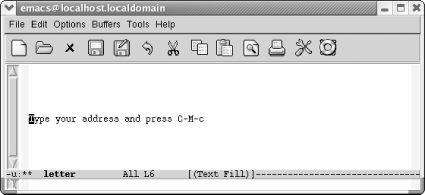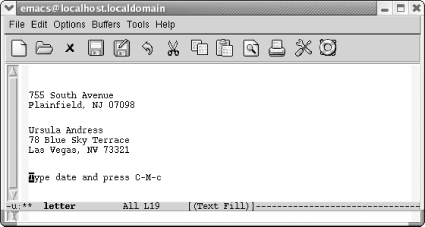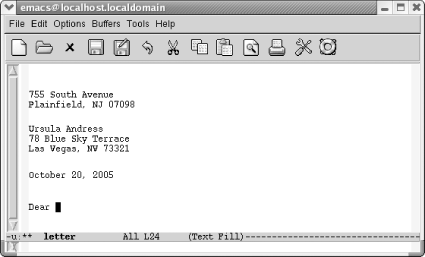6.8. Building More Complicated Macros
| So far, we've covered the basics of writing, executing, and saving keyboard macros. Now let's discuss a couple of more advanced features Emacs lets you add to your macros: pausing a macro for keyboard input and inserting a query in a macro. 6.8.1 Pausing a Macro for Keyboard InputSometimes it's useful to pause a macro briefly so you can type something. For example, if you write a lot of letters, you could have a macro that prints out a template and then pauses for you to fill in variables (such as the date and the recipient's name). You can perform this task (and similar tasks) by inserting a recursive edit into a macro. A recursive edit is just a fancy way to say, "Stop and let me type a while, then pick up the macro where I left off." When you're defining a macro, type C-u C-x q at the point where you want the recursive edit to occur. Emacs enters a recursive edit. (You can tell you're in a recursive edit because square brackets appear on the mode line; you'll see them in the screenshots later in this section.) Nothing you type during the recursive edit becomes a part of the macro. You can type whatever you want to and then press C-M-c to exit the recursive edit. Notice how the square brackets disappear when you type C-M-c. When the square brackets are no longer on the screen, you have left the recursive edit. Anything you type at this point becomes part of the macro. You can put as many pauses in your macros as you want to. 6.8.1.1 ExampleHere's an example of a macro that puts a business letter template on the screen and uses recursive edits to let you type your return address, the recipient's name and address, and the date. Because the brackets on the mode line are a pretty subtle clue to what you are going to type, we'll give the user of this macro explicit instructions about what to type. Table 6-3 provides these instructions.
The following screens show what the macro defined in Table 6-3 looks like when you run it.
Now the macro has finished editing; you can type the recipient's name and then the body of the letter, and of course you can go back and edit any of the information you've already filled in. 6.8.2 Adding a Query to a MacroThe more complex the task your macro performs, the more difficult it is to make the macro general enough to work in every case. Although macros can do a lot of things, they aren't programs: you can't have if statements, loops, and the other things you associate with a program. In particular, a macro can't get input from the user and then take some action on the basis of that input. However, one feature lets a macro get input, in a limited way, from the user. You can create a macro that queries the user while it is running; it works much like a query-replace. To create this kind of a macro, type C-x q when you reach the point in the macro definition where you want the macro to query the user. Nothing happens immediately; go on defining the macro as you normally would. Things get interesting later, when you execute the macro. When it gets to the point in the macro where you typed C-x q, Emacs prints a query in the minibuffer: Proceed with macro? (y, n, RET, C-l, C-r) The responses listed here are analogous to those in query-replace:
6.8.2.1 ExampleLet's say that you write a macro that copies comments from a program to another buffer. The comments in our program are preceded by a slash, so you start the macro with a search for a slash. However, not all comments are worth copying. Following the search with a query lets you decide case by case whether the search has found a comment you want to copy. Table 6-4 shows a macro to copy comments to another buffer.
|
EAN: 2147483647
Pages: 161



